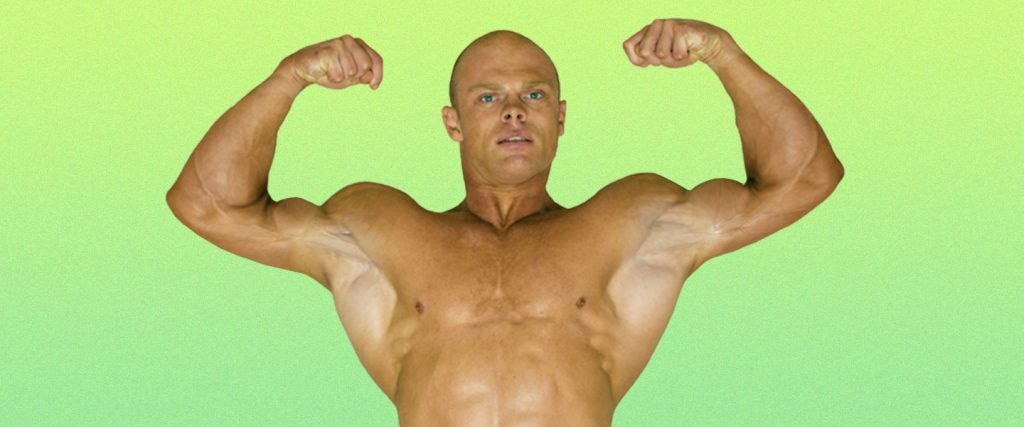Biceps are funny things. On the one hand, they aren’t even considered a major muscle group, and many experts would advise you to train them as an accompaniment to your back day in light of the fact that the biceps are so heavily involved in most of the key pulling movements. On the other hand, flexed biceps are the ultimate symbolic representation of strength.
I mean, when was the last time you said to someone, “Hey! Flex your muscles!” only to have them show off a thigh or a hamstring? Even the majority of bodybuilding trophies are typically topped by the figure of a musclebound man unleashing one or more flexed biceps.
Because the possession of powerful pythons is one of the quickest ways to signify giant-slamming strength (Brother!), I wouldn’t be at all surprised if you told me you devoted more time to molding the muscles in the front of your arms than to nearly any other muscles in your body.
Ha! I train my biceps every time I go to the gym and still see hardly any results. Why don’t I look like a superhero yet?
If you’re doing what I think you’re doing, it could be for several reasons that could all probably be subsumed within one or two categories.
Let’s start with the easiest problem to spot here: You’re overtraining your biceps. Your muscles require plenty of rest after a period of major exertion. This is why many people often target their individual muscle groups no more than once (and certainly no more than twice) per week. Muscles don’t grow while they’re undergoing resistance training; the training is micro tearing the fibers in your muscles in preparation for them to be built back better — like a Joe Biden presidential slogan. By breaking down your biceps on a daily basis and never providing them with an opportunity to recover, you’re never granting them the privilege that they’re undoubtedly pleading for, which is to repair the aforementioned micro tears and generate the size and strength you’re looking for.
You mean to tell me I should have been resting and doing nothing instead of training?
Not exactly. This brings me to the other major issue with your training strategy — the lack of training you’ve been doing in your adjacent muscle groups.
We’ve already discussed the fact that biceps are a secondary muscle group relative to the more prominent movers in your anatomy, like your back, chest and legs. In fact, your biceps are even of secondary significance within your arms, because they only compose two-thirds of the musculature within the most prominent part of your arms; the triceps on the back of your arms provide them with most of their size, along with their appearance of fullness. This means if you’re desperate to add bulk to your arms, your time would be better spent struggling away with dips, skull crushers, tricep extensions and tricep kickbacks as opposed to the endless diet of assorted curls you’ve been feeding your biceps.
Not only will this give your biceps a much-needed break, but it will help the overall growth of your arms while simultaneously strengthening the most critical part of your arms that your biceps directly connect to.
That’s all I need to do? I can just split the training time evenly between my biceps and triceps and then my arms will be more likely to grow?
That would make for a meaningful start, but it will still only amount to one small piece of the bicep-building equation. Even when your biceps and triceps are considered collectively, the arms are still a secondary muscle group that are involved in the training of virtually every other muscle in the upper body. They tie into the rest of your body through the deltoids in your shoulders, and then your shoulders connect with both your chest and back.
In practice, it becomes impossible to develop large muscles in your chest and back without simultaneously generating strong arms. On the flip side, the reverse is not only true, but it’s an absolute certainty: You have never seen an impressive set of muscular arms that wasn’t also capped by a pair of strong, broad shoulders. You’ve also never seen strong shoulders that weren’t also connected to a powerful back and chest.
I don’t understand why all of this is necessary. Why can’t I just grow a huge set of biceps and be done with it?!?!
Your body is intended to make anatomical sense in the way it’s put together. And so, if your biceps can’t tie themselves in with adjacent muscles of similar size and strength, your body will limit their development until the connected muscles catch up in order to prevent imbalances and injuries.
Think of your individual muscles in the same vein as skyscrapers that have lost the title of world’s tallest building, and then the architects’ attempt to vie for the title once again by affixing flimsy antennas to the buildings’ top floors. It looks silly, and no one buys it. Having a single overgrown muscle group would be the bodybuilding equivalent of adding an antenna; it would be an obvious form of overcompensation and a desperate grasp at relevance without performing all of the foundational work.
Knit your body together properly so that it’s a stable, well-rounded structure that you’ll enjoy living in as opposed to attempting to rely on just one stand-out feature. A four-story parking deck may stick out more than a single-story home, but I know which one I’d prefer to reside in.

